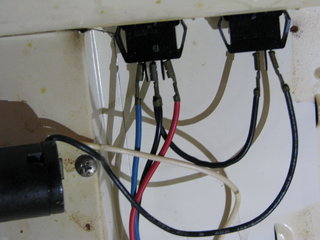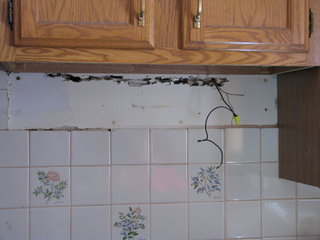A couple days ago, I knocked against the corner of the hood over the range. A screw fell out, and that corner of the hood dropped. I shined a light into the gap and discovered that the screw was never actually sunk into anything. It just skinned the inside of the carcass side on the underside of the cabinet. I looked at the other corners, and discovered mismatched screws. Never a good sign. I put it on the list.
 Today, I decided to do something about. First, the electrics. On a hunch, I grabbed the camera. Never again will I write little notes to myself about what connected where. Nor bother with post-it note flags on the wiring.
Today, I decided to do something about. First, the electrics. On a hunch, I grabbed the camera. Never again will I write little notes to myself about what connected where. Nor bother with post-it note flags on the wiring.
After that, I removed the remaining screws. All 3 practically fell out. Despite that, the hood didn't really fall. The hood was installed before the wall was tiled. Three of the tiles were cut badly. They gaped a quarter-inch below the others. So the installer ran a bead of caulk to hide it. The caulk not only covered the gap, it sealed the hood to the wall and the hood's filter to the wall as well. Which, incidentally, means that the filter in the hood hadn't been changed or cleaned in 20 years. That wasn't the only thing I found, though.

 Today, I decided to do something about. First, the electrics. On a hunch, I grabbed the camera. Never again will I write little notes to myself about what connected where. Nor bother with post-it note flags on the wiring.
Today, I decided to do something about. First, the electrics. On a hunch, I grabbed the camera. Never again will I write little notes to myself about what connected where. Nor bother with post-it note flags on the wiring.After that, I removed the remaining screws. All 3 practically fell out. Despite that, the hood didn't really fall. The hood was installed before the wall was tiled. Three of the tiles were cut badly. They gaped a quarter-inch below the others. So the installer ran a bead of caulk to hide it. The caulk not only covered the gap, it sealed the hood to the wall and the hood's filter to the wall as well. Which, incidentally, means that the filter in the hood hadn't been changed or cleaned in 20 years. That wasn't the only thing I found, though.

That's a 2-foot-long gouge in the drywall. Apparently, the electrician ran the wire up to the left side. The only cut-out in the hood is on the right side. So the installer dragged a screwdriver or something through the drywall. Nice. If you look closely at this picture, you can see the caulk along the top and left edge of the tile, where it adhered to the range hood. You can also see where the paper surface of the drywall tore-away with the hood.
If you look closely at the right rear corner of the underside of the cabinet, you'll see brown plastic. It's a "staple block," I guess. Like a glue block, but for staples. Those caused a headache. The basic problem is that the holes for the screws are inside the sides of the carcass. The obvious solution is to attach scrap lengths of wood so there's something solid to mount the hood on. The fun part was cutting shoulders on the ends of the scrap pieces to account for the "staple blocks." After that, it was pretty straight-forward. Oh, and that hole in the drywall? Duct tape. The only way to really fix it is to replace the drywall. Neither Nicole nor I like the tile, so it's going to be replaced at some point. That means the drywall will be replaced. No point in patching something that's going to be demolished in the next few years, anyway. It might be that someone else will be staring at that duct tape in 10 years wondering what the hell the previous owner was thinking. But I hope not.
If you look closely at the right rear corner of the underside of the cabinet, you'll see brown plastic. It's a "staple block," I guess. Like a glue block, but for staples. Those caused a headache. The basic problem is that the holes for the screws are inside the sides of the carcass. The obvious solution is to attach scrap lengths of wood so there's something solid to mount the hood on. The fun part was cutting shoulders on the ends of the scrap pieces to account for the "staple blocks." After that, it was pretty straight-forward. Oh, and that hole in the drywall? Duct tape. The only way to really fix it is to replace the drywall. Neither Nicole nor I like the tile, so it's going to be replaced at some point. That means the drywall will be replaced. No point in patching something that's going to be demolished in the next few years, anyway. It might be that someone else will be staring at that duct tape in 10 years wondering what the hell the previous owner was thinking. But I hope not.

